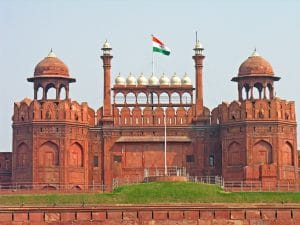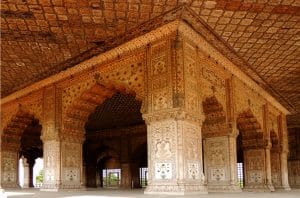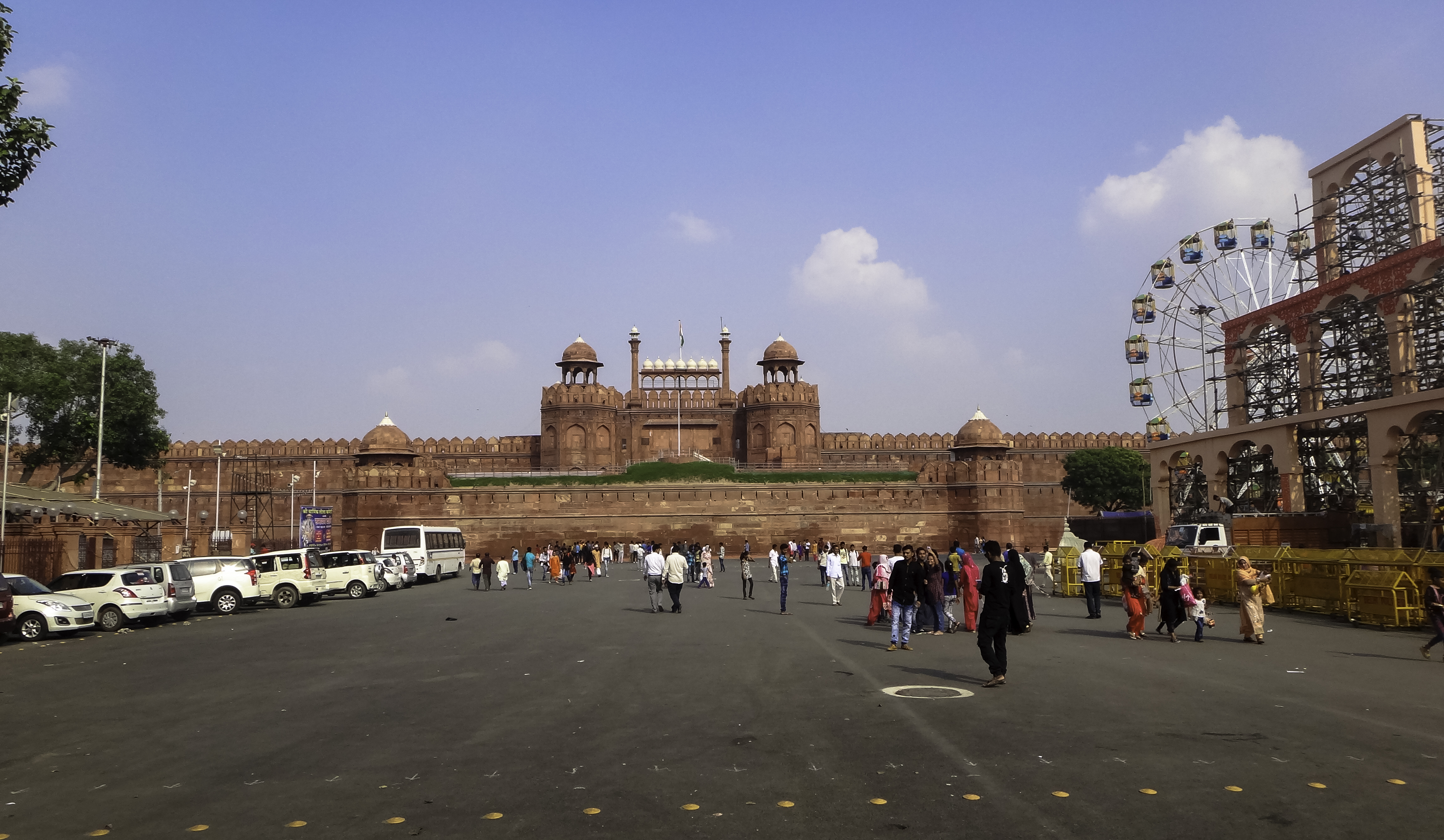Commissioned by the famous Mughal Emperor, Shah Jahan on May 12th, 1638, the Red Fort took almost a decade to be constructed (May 1638 – April 1648). It served as the main residence of the Mughal emperors after Shah Jahan decided to shift his capital from Agra to Delhi.
Its English name, the red fort, is a translation of the Hindi words, Lāl Qila, inferring from its red-sandstone architecture. The fort was initially called Qila-i-Mubārak meaning, “The Blessed Fort”, as it was home to the royal family. The fort of Agra is also recognized as Lāl Qila.

The first Indian prime minister, Jawaharlal Nehru, hoisted the Indian national flag above the Lahori Gate on August 15th, 1947.
Ever since, on every Indian Independence Day(August 15th), the prime minister hoists the Indian “tricolour flag” at the main gate of the fort and gives a speech, broadcasted nationwide from walls of the fort.
In 2007, it was listed as a UNESCO World Heritage Site, as part of the Red Fort Complex.
Let’s look at some interesting facts about the Red Fort of Delhi.
The Architecture Of Red Fort, Delhi
 Originally red and white, the favourite colours of Shah Jahan, its architecture is attributed to the architect, Ustad Ahmad Lahori, who also designed the Taj Mahal.
Originally red and white, the favourite colours of Shah Jahan, its architecture is attributed to the architect, Ustad Ahmad Lahori, who also designed the Taj Mahal.
The glorious Red Fort, built over 255 acres, has an octagonal shape. The top-down view of the fort reveals its grand octagonal form, with its north-south axis longer than the east-west axis.
The later Mughal architecture is elegantly represented by its marble, floral designs and the double domes of the fort.
It showcases a formidable ornamentation standard and the alleged Kohinoor diamond was also a part of the decorations.
Delhi’s Red Fort is one of India’s long-established building complexes giving the gist of a long period of history and its arts. In the run-up to its commemoration as a monument of national importance in 1913, attempts have been made to conserve it for posterity.
Significant Attractions
Red Fort is one of the most notable among the New Delhi tourist attractions. The walls and ramparts, the main doors, the public halls and the royal quarters on the eastern shore are the most significant surviving buildings.
Lahori Gate
 The Lahori Gate, which is identified for its inclination towards Lahore, is the main gate of the Red Fort. The glory of the gateway was compromised during the period of Aurangzeb by installing bastions, described by Shahjahan as “a veil drawn across the face of a beautiful woman”.
The Lahori Gate, which is identified for its inclination towards Lahore, is the main gate of the Red Fort. The glory of the gateway was compromised during the period of Aurangzeb by installing bastions, described by Shahjahan as “a veil drawn across the face of a beautiful woman”.
The National flag is unfurled and the Prime Minister delivers a speech from its walls every Indian Independence Day since 1947.
Delhi Gate
The Delhi Gate is the public gate to the south and is identical in its structure to the Lahori Gate. Two life-size stone elephants on either side of the gate face each other.
Chhatta Chowk

The Chhatta Chowk (or Meena Bazaar) is next to the Lahori Gate, where silk, jewellery and other imperial household goods were traded during the Mughal era.
This market was formerly recognised as Bazaar-i-Musaqqaf (the market with saqaf, meaning roof) or the Chatta-Bazaar (roofed market).
Lahori Gate, the entrance door to the Red Fort, links to an open courtyard, where it crosses a wide north-south road which basically separates the fort’s army functions (to the west) from the manors (to the east). Delhi Gate is the south end of the lane.
Naubat Khana
The arched arcade of the Chhatta Chowk closes in the heart of the outer court, which is estimated to be 540 by 360 feet (160 m × 110 m). The rear arcades and central tank were demolished following the 1857 rebellion.
The now-isolated Naubat Khana (also known as Nakkar Khana), the drum house, sits in the east wall of the court. At scheduled intervals, music was performed every day, and everyone, except royalty, was obliged to descend.
It is rumoured that the Mughal kings Jahandar Shah (1712–13) and Farrukhsiyar (1713–19) have been assassinated here. On the second floor of the red fort, the Indian War Memorial Museum is established.
Diwan-i-Aam
 The Nakkar Khana led to the inner main court(540 ft x 420 ft) was enclosed by guarded corridors. The Diwan-i-Aam, the room for the commoners, was situated on the far side of it.
The Nakkar Khana led to the inner main court(540 ft x 420 ft) was enclosed by guarded corridors. The Diwan-i-Aam, the room for the commoners, was situated on the far side of it.
Originally furnished with white chunam stucco, the hall’s pillars and engrailed curves display exquisite craftsmanship.
The monarch would give his interview in the jharokha, the marble balcony, located in the back in a raised recess.
The Diwan-i-Aam was also used for state gatherings. The courtyard (mardana) behind it led to the royal manors.
Nahr-i-Bihisht
The royal residences comprise a series of pavilions on an elevated platform at the east side of the red fort, overlooking the Yamuna River. The pavilions are linked to the heart of each pavilion via the canal known as the Nahr-i-Bihisht (‘Stream of Paradise’).
A tower, the Shahi Burj, at the northeastern corner of the red fort, is used to draw water from the Yamuna. As mentioned in the Quran, the Palace is built for imitating paradises. The area, known as zer-jharokha (“underneath the latticework,”), was in a riverbed beneath royal residences and linked buildings.
Mumtaz Mahal
Two of the southernmost pavilions of the palace are the zenanas (female’s areas), consisting of the Mumtaz Mahal constructed for Arjumand Banu Begum (Mumtaz Mahal), principal wife of the Mughal emperor Shah Jahan, and the bigger Rang Mahal, a palace for the royal women. The Mumtaz Mahal houses the Red Fort Archaeological Museum.
Rang Mahal

The emperor’s wives and concubines resided in the Rang Mahal, meaning the “Palace of Colours” as it was painted vividly and adorned with a mirrored mosaic.
The Nahr-i-Bihisht (“River of Paradise”) supplied the main marble pool.
Khas Mahal
The king’s residence was the Khas Mahal. The Nahr-i-Bihisht would help cool it. An octagonal tower, the Muthamman Burj is linked to it, where he would be seen in front of the citizens waiting on the coast of the river. Many kings during the period did so.
Diwan-i-Khas
 A gate on Diwan-i-Aam’s northern side opens to the innermost courtyard of the red fort (Jalau Khana) and to Diwan-i-Khas (Hall of Private Guests).
A gate on Diwan-i-Aam’s northern side opens to the innermost courtyard of the red fort (Jalau Khana) and to Diwan-i-Khas (Hall of Private Guests).
Crafted out of white marble, it is decorated with valuable jewels. Wood has replaced the once-silver ceiling. In the 17th century, François Bernier addressed the gems of the Peacock Throne here.
An inscription by the Persian poet Amir Khusrow is imposed on both ends of the hall above the two external arches:
If heaven can be on the face of the earth,
It is this, it is this, it is this.
— ”World Heritage Site – Red Fort, Delhi; Diwan-i-Khas”. Archaeological Survey of India. Retrieved 15 August 2012.
Hammam
Comprising three-domed places, with white marble-patterned grounds, the hammam was the baths for the royals inside the red fort.
Baoli
Believed to pre-date the Red Fort, the baoli or step-well is one of the few sites which the British did not destroy during the Indian Revolt of 1857. The chambers inside the baoli were turned into a jail.
Indian National Army officers Colonel Shah Nawaz Khan, Colonel Prem Kumar Sahgal, and Colonel Gurbaksh Singh Dhillon resided in the baoli during the Indian National Army Trials (Red Fort Trials) from 1945 to 1946. The Red Fort Baoli is distinctively sketched with dual sets of staircases reaching down to the well.
Moti Masjid
The Moti Masjid, the Pearl Mosque, is to the west of the hammam. It was constructed as a private mosque for Aurangzeb in 1659. It is a compact, three-dome mosque rendered in white marble, which is led down to the courtyard by a three-arched screen.
Hira Mahal

The Hira Mahal(“The Diamond Palace”) is a pavilion on the south side of the red fort that was constructed under the Bahadur Shah II and at the end of the Hayat Bakhsh Bagh.
During (or after) the revolt of 1857, the Moti Mahal, a twin building, on the northern side was demolished. The Shahi Burj was the primary study of the Emperor; its name meaning “Emperor’s Tower” and originally had a chhatri(dome) on the top.
The tower is under repair and has been severely damaged. A later addition by Aurangzeb, there is a marble pavilion facing it.
Hayat Bakhsh Bagh
In the north-eastern section of the red fort, is a “Life-Bestowing Garden”, the Hayat Bakhsh Bagh. It has a now-dry reservoir and channels through which flows the Nahr-i-Bihisht.
The white marble pavilions, the Sawan and Bhadon Pavilions, named after the Hindu months, Sawan and Bhadon, are situated at either end. A later extension around 1842 by Bahadur Shah Zafar, is the red-sandstone Zafar Mahal, named after him, standing amidst the reservoir.
On its western edge, were some smaller gardens such as the Mehtab Bagh or Moonlight Garden which were later demolished when the British barracks were constructed. The gardens are intended to be reconstructed. Beyond these, an arched bridge and the Salimgarh Fort are led by the road to the north.
Princes’ manors
The manors of the royal princes’ are situated to the north of the Hayat Bakhsh Bagh and Shahi Burj. The members of the Mughal Royalty utilized these manors, which were widely demolished by the British troops after the rebellion. One of the manors had been transformed into a tea house for the troops.
Prominent Universal Significance Of The Red Fort, Delhi
 The layout and design of the Red Fort in Delhi reflect the beginning of the architectural advancement started by the first Mughal Ruler in 1526 AD.
The layout and design of the Red Fort in Delhi reflect the beginning of the architectural advancement started by the first Mughal Ruler in 1526 AD.
Shah Jahan brought a marvellous refinement to the architecture of the Red Fort by merging Islamic, Persian, Timurid and Hindu cultures.
Later buildings and gardens in Rajasthan, Delhi, Agra and more afield were greatly impacted by the state-of-the-art planning compositions and structural fashion of building elements as well as the garden layout originated from the Red Fort.
It has been the backdrop for events which have had a significant influence on its geo-cultural precinct.
The Red Fort Complex is a prominent representation of both Mughal architecture and planning and the succeeding British military application of the forts.
The most drastic consequences on the honour of the Red Fort Complex are attributed to the river being turned into the main road that changes the property’s connection to its planned environment, and from the division of the Salimgarh Fort by a railway.
The Salimgarh Fort, however, is inevitably connected to the Red Fort in usage and subsequent past. Only by its significance as part of the entire Red Fort Complex can the integrity of the Salimgarh Fort be identified.
The credibility of the Mughal and British properties in the Red Fort Complex is authorised, whilst more effort is required to authenticate the integrity of the present garden design.
 The credibility of the Mughal era is akin to the understanding of its usefulness and connections, and of the established buildings recorded from the British era particularly for the Salimgarh Fort.
The credibility of the Mughal era is akin to the understanding of its usefulness and connections, and of the established buildings recorded from the British era particularly for the Salimgarh Fort.
Under the Ancient Monument and Archaeological Sites and Remains Act of 1959, the designated estate has been proclaimed a site of national significance. It established a buffer zone.
While the property’s sustainability status has enhanced in the past ten years, substantial effort is required to ensure that the property’s overall condition stays secure and that tourists will not add to its deterioration.
The Red Fort Complex is closely operated by the Archeological Survey of India, which also preserves the Indian heritage sites and Indian cultural grounds on the World Heritage List.
Security At Red Fort, Delhi
The surveillance around the Red Fort, on the eve of Indian Independence Day, is particularly strict to avoid acts of terrorism. Delhi police and paramilitaries are patrolling the communities surrounding the fort and sharpshooters from the National Security Guard are stationed in high-rising places around the fort.
During the celebration, to deter an aerial strike, the sky above the fort is declared a no-fly region and there are secure condos in surrounding areas to which the Prime Minister and other Indian leaders will flee in case of an outbreak.
Having endured the tests of time, Red Fort is a must-visit that will take you on a journey back in time. This fort carries the testimony to various occurrences throughout history.
FAQs About Red Fort, Delhi

Q. Who Built Red Fort?
A. Commissioned by the famous Mughal Emperor, Shah Jahan on May 12th, 1638, the Red Fort took almost a decade to be constructed (May 1638 – April 1648). Originally red and white, the favourite colours of Shah Jahan, its architecture is attributed to the architect, Ustad Ahmad Lahori, who also designed the Taj Mahal.
Q. What Are Red Fort Timings?
A. The timings for Red Fort New Delhi are:
- OPEN: TUE-SUN 9:30 AM to 4:30 PM
- CLOSED: MONDAY
Q. What Is The Best Time To Visit?
A. The following is the best time to visit the red fort.
- RECOMMENDED: November to March
- MONSOON: August To September
- SUMMER: Early April. Peak in May (32°C avg)
- WINTER: November. Peak in January(12-13°C avg)
Q. What Are The Ticket Prices?
A. The price for Red Fort Tickets are as follows:
- Indians: 35 INR
- Foreigners: 500-550 INR (6.59 – 7.25 USD approx.)
Q. What Are The Ticket Prices For The Light And Sound Show?
A. The ticket price for the Light and Sound Show at Red Fort are as follows:
WEEKDAYS
- Adult: Rs. 60
- Child: Rs. 20
WEEKENDS
- Adult: Rs. 80
- Child: Rs. 30
Q. Where Is The Red Fort Located?
A. The red fort is located at Netaji Subhash Marg, Lal Qila, Chandni Chowk, New Delhi, Delhi India 110006. The following are the suggested ways to get there:
- NEAREST AIRPORT TO RED FORT: Indira Gandhi International Airport
- NEAREST RAILWAY STATION TO RED FORT: Old Delhi Railway Station
- NEAREST METRO STATION TO RED FORT: Chandni Chowk Metro Station
- NEAREST BUS STAND TO RED FORT: Kashmiri Gate Bus Station
Q. What Are The Facilities Available At The Red Fort?
A. The red fort facilities are as follows:
- Drinking water
- Parking
- Toilets (separate for males and females)
- Photography (charges nil) & Videography(charges 25 INR)
- Various other facilities are available at or near the monument. Accommodation facilities are available near the monument.
Also Read: UNESCO World Heritage Sites In India (Updated 2020)
Plan Your Tour With Us
Let us help you get the best out of your holidays and a hassle-free trip. Tell us more about your travel plans and we certainly offer you something of your choice & budget.
Home| Blog | About Us | Instagram |Work With Us | Store

